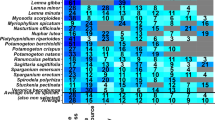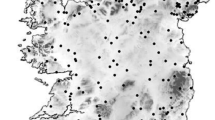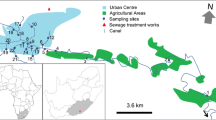Abstract
In this paper we analyzed nutrient concentration in the channels of eastern Croatia and investigated whether certain plant species and associations can be used as direct estimators of water quality. One hundred and twenty-two channel sites were visited and water samples taken for laboratory analysis (pH and concentrations of sulfate, chloride, ammonium, nitrate, and total phosphorus). At each site, macrophyte vegetation was recognized and its occurrence recorded. Three groups of analyses were performed: (a) principal component analysis to describe habitat characteristics of the investigated channels, (b) stepwise regression analysis to build estimation models for nutrient concentrations, and (c) geostatistical analysis including fitting of variograms and interpolation of values over the whole area of interest. High values of water nutrients in the eastern Croatian channels were reported (90% intervals): 5.3–29.4 for nitrates, 27.8–54.2 for sulfates, 0.1–0.4 for total P, and 0.18–0.34 mg l−1 for ammonium. Water nutrient concentrations can be successfully mapped over the channel network in eastern Croatia using geostatistics (regression kriging). The nutrient concentration variables required log transformation prior to regression or variogram analysis because their distributions were distinctly skewed towards lower values. Species were found to be a more successful estimator of nutrient concentrations than plant associations. In all cases, species had a higher adjusted R-square value, ranging from 0.302 (ammonium) to 0.485 (sulfates). Additional load of nutrients in water could lead to the disappearance of the more-sensitive species Lemna trisulca, Riccia fluitans, and Ricciocarpus natans and the spread of Potamogeton pectinatus, Glyceria maxima, and Glyceria fluitans. Further studies are needed to develop strategies for incorporating permanent monitoring networks to observe environmental changes and succession of vegetation.




Similar content being viewed by others
References
American Public Health Association (APHA) 1998. Standard Methods for the Examination of Water and Wastewater, 19th ed. In Greenberg, A. E., L. S. Clesceri & A. D. Eaton (eds), Washington, DC.
Baattrup-Pedersen, A. & T. Riis, 1999. Macrophyte diversity and composition in relation to substratum characteristics in regulated and unregulated Danish streams. Freshwater Biology 42: 375–385.
Bini, L. M., S. M. Thomaz, K. J. Murphy & A. F. M. Camargo, 1999. Aquatic macrophyte distribution in relation to water and sediment conditions in the Itaipu Reservoir, Brazil. Hydrobiologia 415: 147–154.
Bouldin, J. L., J. L. Farris, M. T. Moore & C. M. Cooper, 2004. Vegetative and structural characteristics of agricultural drainages in the Mississippi Delta landscapes. Environmental Pollution 132: 403–411.
Braun-Blanquet, J., 1964. Pflanzensoziologie. Springer Verlag, Wien, New York.
Brönmark, C. & L. A. Hansson, 1998. The Biology of Lakes and Ponds. Oxford University Press, Oxford.
Carpenter, S. R., N. F. Caraco, D. L. Correll, R. W. Howarth, A. N. Sharpley & V. H. Smith, 1998. Nonpoint pollution of surface waters with phosphorus and nitrogen. Ecological Applications 8: 559–568.
Casper, C. J. & H. D. Krausch, 1980. Pteridophyta und Anthophyta 23/24. In Ettl H., J. Gerloff & H. Heynig (eds) Die Süßwassflora von Mitteleuropa. Gustav Fischer Verlag, Stuttgart.
Daniel, H., I. Bernez & J. Haury, 2006. Relationships between macrophytic vegetation and physical features of river habitats: The need for a morphological approach. Hydrobiologia 570: 11–17.
Dawson, F. H. & K. Szoszkiewicz, 1999. Relationships of some ecological factors with the associations of vegetation in British rivers. Hydrobiologia 415: 117–122.
Demars, B. O. L. & D. M. Harper, 1998. The aquatic macrophytes of an English lowland river system: Assessing response to nutrient enrichment. Hydrobiologia 384: 75–88.
Guisan, A. & N. E. Zimmermann, 2000. Predictive habitat distribution models in ecology. Ecological Modelling 135: 147–186.
Haury, J., 1996. Assessing functional typology involving water quality, physical features and macrophytes in a Normandy river. Hydrobiologia 340: 43–49.
Heegaard, E., H. H. Birks, C. E. Gibson, S. J. Smith & S. Wolfe-Murphy, 2001. Species-environmental relationships of aquatic macrophytes in Northern Ireland. Aquatic Botany 70: 175–223.
Hengl, T., 2007. A Practical Guide to Geostatistical Mapping of Environmental Variables. EUR 22904 EN Scientific and Technical Research series, Office for Official Publications of the European Communities, Luxemburg.
Hengl, T., G. B. M. Heuvelink & D. G. Rossiter, 2007. About regression-kriging: From equations to case studies. Computers and Geosciences 33: 1301–1315.
Janauer, G. A., 2001. Is what has been measured of any direct relevance to the success of the macrophyte in its particular environment? Journal of Limnology 60: 33–38.
Johnson, L. B. & S. H. Gage, 1997. Landscape approaches to the analysis of aquatic ecosystems. Freshwater Biology 37: 113–132.
Jongman, R. H. G., C. J. F. Ter Braak & O. F. R. Van Tongeren, 1995. Data Analysis in Community and Lanscape Ecology, 2nd ed. Cambridge University Press, Cambridge.
Kohler, A., & G. Janauer, 1995. Zur Methodik der Untersuchung von Fließgewässern mit Hilfe von aquatischen Makrophyten. In Steinberg, C. E. W., H. Bernhardt & H. Klapper (eds), Handbuch Angewandte Limnologie. Ecomed: 1–22.
Landolt, E., 1986. Biosystematic Investigations in the Family of Duckweeds (Lemnaceae). Veröffentlichungen des Geobotanischen Institutes ETH, Stiftung Rübel, Zürich.
Nurminen, L., 2003. Macrophyte species composition reflecting water quality changes in adjacent water bodies of lake Hiidenvesi. Annales Botanici Fennici 40: 199–208.
OECD, 1982. Eutrophication of Waters: Monitoring, Assessments and Control. Organisation for Economic Cooperation & Development, Paris.
Parsons, J., 2001. Aquatic Plant Sampling Protocols. Environmental Assessment Program Olympia, Washington State Department of Ecology, Washington.
Peterson, E. E., A. A. Merton, D. M. Theobald & N. S. Urquhart, 2006. Patterns of spatial autocorrelation in stream water chemistry. Environmental Monitoring and Assessment 121: 571–596.
Preston, C. D., 1995. Pondweeds of Great Britain and Ireland. BSBI Handbook No 8. Botanical Society of the British Isles, London.
Riis, T. & K. Sand-Jensen, 2001. Historical changes in species composition and richness accompanying perturbation and eutrophication of Danish lowland streams over 100 years. Freshwater Biology 46: 269–280.
Riis, T. & K. Sand-Jensen, 2002. Abundance-range size relationships in stream vegetation in Denmark. Plant Ecology 161: 175–183.
Riis, T., K. Sand-Jensen & S. E. Larsen, 2001. Plant distribution and abundance in relation to physical conditions and location within Danish stream systems. Hydrobiologia 448: 217–228.
Sand-Jensen, K., M. F. Pedersen & S. L. Nielsen, 1992. Photosynthetic use of inorganic carbon among primary and secondary water plants in streams. Freshwater Biology 27: 283–293.
Sauquet, E., 2006. Mapping mean annual river discharges: Geostatistical developments for incorporating river network dependencies. Journal of Hydrology 331: 300–314.
Schneider, S. & A. Melzer, 2003. The trophic index of macrophytes (TIM), a new tool for indicating the trophic status of running waters. International Revue Hydrobiologie 88: 49–67.
Smith, R. A., G. E. Schwartz & R. B. Alexander, 1997. Regional interpretation of water-quality monitoring data. Water Resources Research 33: 2781–2798.
Szańkowski, M. & S. Klosowski, 1999. Habitat conditions of nymphaeid associations in Poland. Hydrobiologia 415: 177–185.
Thiébaut, G. & S. Muller, 1999. A macrophyte communities sequence as an indicator of eutrophication and acidification levels in weakly mineralised streams in north-eastern France. Hydrobiologia 410: 17–24.
Toivonen, H., 1985. Changes in the pleustic macrophyte flora of 54 small Finnish lakes in 54 years. Annales Botanici Fennici 22: 33–44.
Topić, J., 1989. Vegetation of the Special Zoological Reserve of Kopački Rit. Hydrobiologia 182: 149–160.
Tremp, H., 2007. Spatial and environmental effects on hydrophytic macrophyte occurrence in the Upper Rhine floodplain (Germany). Hydrobiologia 586: 167–177.
Tutin, T. G., V. H. Heywood, N. A. Burges, D. M. Moore, D. H. Valentine, S. M. Walters & D. H. Webb (eds), 1968–1993. Flora Europaea, Vol. 1–5. Cambridge University Press, Cambridge.
Wetzel, R. G., 2001. Limnology: Lake and River Ecosystems, 3rd ed. Academic Press.
Yuan, L. L., 2004. Using spatial interpolation to estimate stressor levels in unsampled streams. Environmental Monitoring and Assessment 94: 23–38.
Acknowledgments
The authors would like to acknowledge to S. M. Thomaz and two anonymous reviewers for constructive and helpful comments and Jadranka Zlomislić, MA and Rebecca Javorsky for significantly improving the English version of this paper.
Author information
Authors and Affiliations
Corresponding author
Additional information
Handling editor: S. M. Thomaz
Rights and permissions
About this article
Cite this article
Kočić, A., Hengl, T. & Horvatić, J. Water nutrient concentrations in channels in relation to occurrence of aquatic plants: a case study in eastern Croatia. Hydrobiologia 603, 253–266 (2008). https://doi.org/10.1007/s10750-007-9276-x
Received:
Revised:
Accepted:
Published:
Issue Date:
DOI: https://doi.org/10.1007/s10750-007-9276-x




